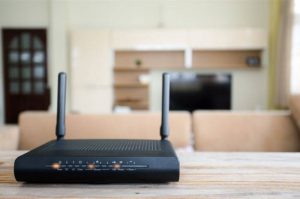Our work and home lives have undergone a radical transformation as South Africans navigate through the nation-wide coronavirus lockdown. While there’s no clear end to the lockdown in sight, many South Africans will continue to work and entertain themselves at home for the foreseeable future. Of course, with all this time spent inside, the importance of having a reliable internet connection at home has never been more evident. A good internet connection is important, not only for entertainment purposes to keep cabin fever at bay but especially for those who will be working from home.
But, with so many people being forced to stay home all day, it’s not uncommon to experience issues with your internet connectivity during this time. There are many reasons why your fibre line may seem slower than usual or why your router may be giving you trouble. Bu, before you call your ISP to log a complaint, you’d be surprised how many of those issues can be easily fixed.
Here are just a few ways to ensure your fibre to the home internet connection is up to the task and you’re getting the most your of your WiFi router:
What internet speed do I need?
Your internet speed needs will largely depend on your needs for work and entertainment purposes as well as your budget. A good rule of thumb to follow for most household use is to look at a speed of 10 Mbps.
Many households may need faster speeds due to data-intense work projects or hobbies. For example, occupations such as civil engineers, creative designers or photographer will use a great deal more data than a bookkeeper working from home. Of course, if your work requires you to participate in frequent remote video conference calls using Facetime, Zoom, or Whatsapp video, then you could also need a faster line speed to accommodate these data-intensive applications.
Your hobbies also contribute to your line speed needs. If you intend to use your fibre connection to play data-intensive games online, you may also require a faster connection and it is also important to consider how many people are using the connection. If you have a traditional family unit that comprises mom and dad that need to work, while the kids are using streaming platforms such as Netflix or YouTube, you may need a higher speed connection.

Another important considering is budget. While you may not be able to afford more than a 10 Mbps line, try to opt for the fastest line you can afford to minimise lag. Check with your service provider about upgrading your line and the costs involved.
What if my WiFi signal is weak?
If you are experiencing a slow fibre connection despite increasing your line speed, there may be a few reasons behind the slower speeds you are experiencing. There are things you can to do to ensure your fibre internet connection operates optimally:
Number of devices connecting to the line:
First off, consider the number of devices connecting to the line. Take stock of how many devices are connected to your fibre line. If need be, limit these devices during periods where you need to make use of your bandwidth, such as video conference calls and the like. If the whole family is connected at the same time, with multiple devices, chances are you could experience a lag on your line speed.
Distance from the router:

The distance from the router is also a consideration. Your home office would typically be as far away from noisy areas as possible, which could mean that your internet line speed in this area is perfect, but the signal strength from you WiFi router will decrease the further you move away. If you’re experiencing slower speeds in other areas of the home, consider investing in a signal repeater, that will strengthen the WiFi signal in your home. You won’t be able to purchase a repeater during the lockdown but you can add it to your shopping list to sort out when the lockdown is lifted. For the time being, if you’re performing high-date tasks consider connecting your computer or device directly to the router via an Ethernet cable or move closer to the router.
Find the best prices on Ethernet cables and other home office tech essentials online with PriceCheck:
Give your router a rest:
Reset your router from time to time. Rebooting your router by switching it off and waiting for 30 seconds before turning it on again often solves connectivity issues, which usually arise from minor software faults in routers that are left on for extended periods.
Age of your WiFi router:
The age of your WiFi router could also be causing issues with speed. Outdated hardware, especially with computers and mobile devices, is a well-known limiting factor. If you have a 10 Mbps internet line but your old WiFi router has a maximum output of 5 Mbps, you’ll only ever get up to half of what you’re paying for. Also, even if your router is not outdated, the firmware may need an occasional update.
Find the best prices on WiFi routers and other home office essentials online with PriceCheck:
Move disruptive appliances
Other appliances in your home could be to blame for slow WiFi speeds. Move disruptive appliances away from your router to see if it helps increase speeds. Appliances such as microwaves, baby monitors, cordless phones and even other routers can broadcast signals which actively congest your WiFi spectrum if you are operating on the 2.4Ghz frequency. If you have any of these appliances positioned nearby your router, try moving them away and see if there’s an improvement.
Location, location, location:

When it comes to router speeds, the location of your router is key. The positioning of your router inside your home or office can impact your signal strength. For most fibre users your Termination Point (TP) is installed in the most convenient installation location, in some cases before you move in. It can be quite costly to get this point moved, so rather consider using range extenders to get the WiFi signal throughout your house. Also, you’ll want the devices that have the most extensive internet data use, such as your smart TV or computer as close to the router as possible.
What’s your frequency?
The frequency of your router could also be a contributing factor to slow internet speeds. The 2.4Ghz frequency can cover a wider area but is more prone to interference and speed drops. 5Ghz, on the other hand, provides better speeds at close range but isn’t great at distance and suffers from interference from walls. Use 2.4Ghz for wide-range areas of your home and 5Ghz near bandwidth-intensive devices. Remember that the WiFi signal becomes weaker the further it needs to travel, which is called path loss.
Forget wireless:
If you’re struggling with speeds and cannot afford to upgrade your line at this time, consider using wired connections to your router. You will find that video streaming is data-intensive and may require more bandwidth, causing other services and devices to lag. As more users connect to the WiFi, you may notice periodic lag depending on the number of WiFi users and their usage requirements. A wired ethernet cable connection is always more stable than the WiFi signal from the same router. For bandwidth-intensive activities like gaming, video calls, and high definition streaming, consider using a wired connection to your laptop or computer instead. Also, by making use of a cable you will be redirecting traffic from the WiFi router and reducing some of the WiFi traffic.
If all else fails and you’re still experiencing issues with your connectivity, contact your ISP to assist. Technicians are familiar with the challenges so they can help you troubleshoot remotely during the lockdown and find a workable solution.
Find the best prices on home office tech essentials online with PriceCheck:





